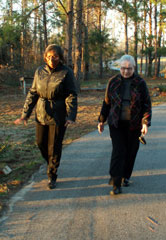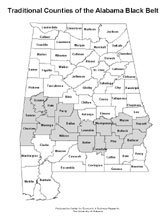Community Health Advisors Light Up Alabama’s Black Belt
March 2006

Doris Smith, left, a community health advisor and trainer, walks with Vee Stalker, community core liaison for the Flying Sparks project, on the walking trail in Pine Apple, AL that was built because of the efforts of community health advisors who participated in the UAB program.
The light from John the Baptist Church in Orrville, Alabama, could be seen a mile down the dark county road. Inside, 12 residents of the largely African American, rural region called Alabama’s “Black Belt,” took their first steps in learning to be community health advisors.
The group is part of the Flying Sparks study, in which researchers are testing if a proven peer educator training program has wings of its own.
Orrville is one of 22 Black Belt communities that are being trained by the University of Alabama at Birmingham’s Center for Health Promotion, one of the Prevention Research Centers supported by the Centers for Disease Control and Prevention. Community health advisors will learn about diabetes, stroke, tobacco, and heart disease—all major problems in this region—and learn how to promote physical activity and good nutrition in communities where the nearest doctor’s office can be an hour’s car ride away.
“People perish because of lack of knowledge,” said Jerolene Williams, a school administrator and wife of the church’s pastor, who said she recruited volunteers because she saw a need in her community for more health resources.
The communities will get varying levels of assistance from the center as it tests how much assistance is needed to implement the training and what factors determine success.
Connie Kohler, principal investigator for the Flying Sparks project, said
she suspects that the amount of “social capital” will make a big difference,
or whether people in the community have the ability to work together and
trust each other. Researchers at the center have developed a survey to
assess the level of social capital.

The Black Belt region is named after its rich, black soil, but may be known better for its poor material resources. In some areas, the population density is a mere 15 people per square mile, and banks, hospitals, and grocery stores are sparse. In one Black Belt county in the study, the high school graduation rate is only 60 percent and half of the children live in poverty.
Doris Smith, a 10-year community health advisor who grew up in the area and now helps lead the training effort, said that in the past 15 years she has seen saw mills and sewing factories that used to employ locals move out, leaving more people to depend on public assistance.
The economic situation goes hand-in-hand with health problems, researchers say. Vee Stalker, community core director for the project, said that not only are doctors in short supply in the area, so are medical necessities such as insulin for people with diabetes, and social resources such as support groups. Chronic disease flourishes in this area, according to the Alabama Department of Public Health. Obesity rates are higher than in the rest of the state; in fact, a 2004 study by the Auburn Cooperative Extension System found the percentage of overweight girls aged 9 to 10 in the Black Belt was twice the national average.
Racial mistrust also lingers among some people in the Black Belt, which encompasses the cities of Montgomery and Selma and was a hub of the civil rights movement. Some people believe that doctors are racist and do not take their concerns seriously, and so avoid physicians until their problems are life-threatening, Ms. Stalker said. Other people just can’t afford the gas money to see a doctor.
UAB researchers began working with community health advisors in the Black Belt in 1995, when CDC funded an intervention to prevent cardiovascular disease among women in Uniontown, a town of 1,730 people in Perry County. Over the past decade the center and its partners have graduated 130 community health advisors in two counties.
These advisors have subsequently obtained funding from foundations and local government to build a walking trail, and have led walking groups and aerobics classes. With the help of the Alabama Farmers Market Authority they have brought fresh produce to several small towns. They have also trained parents in low-fat cooking techniques and organized healthy church dinners.
“You hear people talking about, ‘I shouldn’t be eating this,’” Ms. Smith said. “They started reading labels. A lot of little exercise groups started.”
Now, the center wants to replicate this success.

The Flying Sparks toolkit includes manuals, a cookbook and other materials to educate community health advisors and help them bring awareness to their communities.
Each of the new communities receives a toolkit that includes community health advisor training manuals, activities, and a cookbook, written with community input, that amends traditional southern recipes to include less fat and salt. Dishes include “mock fried chicken” that is baked and collard greens flavored with turkey instead of ham. The manual includes facts on common conditions, discussion topics, and advice on helping neighbors develop action plans to tackle health problems. Some communities, such as Orrville, will receive hands-on help and visits from the university, while others will get a four-hour training session and help by telephone and e-mail.
Researchers want to discover the most effective way to choose promising communities and to spread the program in other rural and underdeveloped areas.
Ms. Stalker said community health advisors are especially effective in isolated communities where people lack transportation and institutional resources. “In rural communities, people depend on each other more,” she said. This type of peer-helper model, which has been used in Latin America and across the United States, tends to be successful in cultures that emphasize family and community, she said. The health advisors are natural leaders who share geography, culture, and ethnic background with the neighbors they are impassioned to help.
“We are more likely to make changes in behaviors if someone who is similar to us makes a connection or shares information,” Ms. Stalker said.
In addition to learning about common health problems, trainees in the program are encouraged to identify community-specific issues. The women at John the Baptist Church decided to add focus on high blood pressure, teenage pregnancy, and marijuana use.
Ethel Johnson, the community coordinator for the Flying Sparks project, who was raised in the Black Belt, said that while a lack of education, poverty, and drugs are obstacles to health, so is getting people out of their complacency. That’s where community health advisors who are good motivators come into play.
“I’ve heard people say, ‘Well, my mother was overweight, I’m going to be big. I’m big-boned,’” Ms. Johnson said. “People are set in their ways. I tell them, ‘You be the first person to make the change. You be the first to stop eating ham hocks. You do it, and your children will do it.’”
![]() One or more documents on this Web page is available in Portable Document Format
(PDF). You will need Acrobat
Reader (a free application) to view and print these documents.
One or more documents on this Web page is available in Portable Document Format
(PDF). You will need Acrobat
Reader (a free application) to view and print these documents.
- Page last reviewed: December 10, 2008
- Page last updated: November 17, 2007
- Content source: Division of Adult and Community Health, National Center for Chronic Disease Prevention and Health Promotion
Get email updates
To receive email updates about this site, enter your email address:
Contact Us:
- Prevention Research Centers
4770 Buford Hwy, NE
MS K-45
Atlanta, GA 30341-3717 - cdcinfo@cdc.gov

